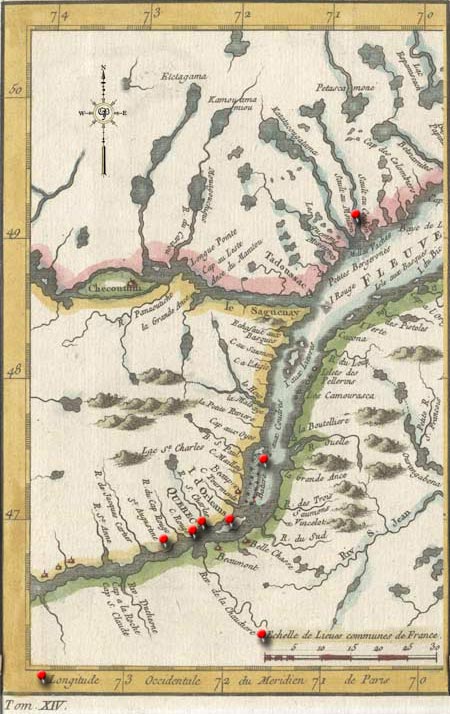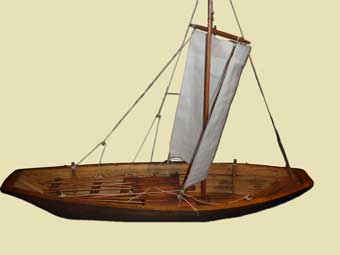Navigateur.
At the time of Michel's birth in 1746 Pierre was a navigateur, a line of work that required familiarity with the location of the shoals, rapids and other hazards in the waterways.
The tools navigators used on the open seas in the 1700's would include a portolan, compass rose, backstaff, traverse board, chip log and a sand glass. For inland navigation, charts like this one which illustrated points onshore such as church steeples, mountain ridges or rivers, helped guide them.

The Fleuve Saint-Laurent had to be traversed with care to avoid its dangerous eddies, shoals, and rapids. Ocean tides affect the flow as far inland as Trois-Rivières where the formidable river finally drops to sea level after its long trek from the Great Lakes. The river's brackish waters close to ville de Québec are home to Atlantic sturgeons which live up to 60 years, reaching lengths up to 14 feet or 4.5 meters. Fishermen caught bass, carp, walleye, muskies, smelt, herring, and shrimp alongside walrus and snowy white beluga whales. Eels were a favorite dish for the French back home.
His Children.
The family lived in Saint-Augustin-de-Desmaures, and yet the births of two children are recorded in the capital, Ville de Québec. After the harvests were in there was little for the habitants to do during the cold winter months. Many in the area gathered in the capital both for safety and for the vibrant social life it offered. It was perhaps under these circumstances that brought Barbe to the town for the births of her two older children.
Our ancestor Pierre was born on 20 May 1748 and baptized in Ville de Québec. In this record his father was said to be a journalier. The frozen river did not lend itself to much fishing or boating. But the joy of the birth of their second child was tempered by the loss of their first. Little Michel died at the age of two in October and was buried on the 26th of that month. A year passed and another son, Joseph, was born 29 October 1749 in Saint-Augustin-de-Desmaures.
A Contract.
Joseph Routier was a master mason who owned several quarries including one at Cap-Rouge that produced sandstone used on buildings in Ville de Québec. Stone and wood was transported in a small 54 tonneau charroy, a type of barge rigged with sails that he owned named the Saint-Joseph. On 19 February 1751 Jean-Baptiste Robert, who lived on rue de la Vanne within the Québec city walls, was engaged as master and Pierre was to assist. It was stipulated that if Robert was unable to perform the service Pétel would step in as master under the same terms.

For the voyage they would be paid 385 livres, receiving a portion in advance. They were responsible for the boat and would share in the cost if any of their actions caused any harm to come to it or the cargo. The transport was to take place between April and December when the river was no longer encased in ice.
Records do not reveal what happened next, but it is known that Pierre was dead two months later at the age of 32. The death record asserts he received the final sacraments of the church and was buried in the church cemetery in Saint-Augustin-de-Desmaures on 17 April 1751.
